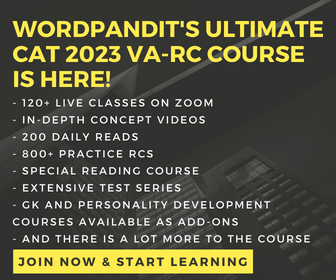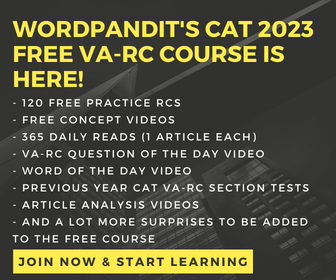CAT 2021 : Parajumbles
What is a Para-Jumble?
As the name of the topic suggests, we encounter jumbling here. But the name of the topic is in a way misleading, because we are not jumbling paragraphs here but we are actually straightening out jumbled sentences in a paragraph. This type of question is actually pretty common in CAT and in recent years, CAT question setters have shown quite a propensity for these questions.
But what exactly is required of us?
Click (+) to expand
A sample question
In order to provide you with a simple starting point, solve the question below. The directions for solving it are simple (these are the ones issued by CAT as well): The sentences given in each question, when properly sequenced, form a coherent paragraph. Each sentence is labelled with a letter. Choose the most logical order of sentences from among the given choices to construct a coherent paragraph.
- On Monday the secretary of state is due to hold a day of meetings with high-level political, military and business figures to further a “strategic dialogue” aimed at further expansion of US trade in India.
B. US secretary of state Hillary Clinton arrived in India on Sunday for strategic talks aimed at bolstering bilateral ties and securing firmer support for the war in Afghanistan.
C. Clinton arrived by plane in Delhi before noon, according to a reporter travelling with her, ahead of expected talks with Prime Minister Manmohan Singh and President Pratibha Patel in the evening. - BAC 2. BCA 3. CBA 4. CAB
This is a fairly easy question and hope each one of you was able to identify Option 2, BCA, as the correct answer. The key points for identifying the correct answer in this case are:
- Statement B forms the perfect starting sentence, providing us with the ideal introduction for hat is to follow.
- Statements C and A take forward the paragraph in the chronological order in which the events are scheduled, with first the explanation for the evening being provided and then for the next day.
Key Skills Required
The key skills that are identified for solving a para-jumble question are as follows:
- Understanding the topic of the paragraph: One should be able to discern what is being talked about, because the subject of individual sentences forms the most important clue for establishing links between various sentences.
- Understanding the information flow and approach of author: The second thing that is pivotal to indentify is the information flow that has been adopted by the author. What is his exact purpose in the paragraph? Is he explicating something or is he criticizing something? Being able to identify his purpose in the paragraph will obviously help us to establish the order of sentences.
A pre-requisite to develop the two skills above is to possess the qualities of a Good Reader. In any case, you would have realized by now that the above qualities are actually the product of possessing a good reading habit. So kindly keep in mind that as much exposure you provide yourself to varied reading material as possible.
Strategies for solving a Para-Jumble
A number of points can be kept in mind while solving a para-jumble question. 6 of these have been listed here. Kindly keep in mind that these would have to be applied in close coordination with one another in most cases, and individual application of these might not solve the question.
STRATEGY 1: Identifying the opening sentence
The first thing that you need to do it to identify the opening sentence of the paragraph. If you can do that, then you will be able to fix at least one sentence in its position. As an example solve the following question:
- In bulk processing, a set of standard prices typically emerge.
B. Competing therefore means keeping products flowing, trying to improve quality, getting costs down.
C. Let us look at the two cultures of competition.
D. Production tends to be repetitive-much the same from day to day or even year to year. (CAT 1996) - CDBA 2. ABDC
3. CADB 4. DCBA
The opening sentence in this case is clearly statement C. It introduces the two cultures of completion and then statement A goes on to explain bulk processing. Rest of sentences are actually just an explanation of the same and go into details of bulk processing. Such a format is generally referred to as General to Specific flow of information, and this method is generally maintained in writing. This can also be sued a reliable guide to solve questions, wherein you identify the general statement first and then move to specific ones.
STRATEGY 2: Identifying the closing sentence
The second strategy to solve a para-jumble question is to identify the sentence with which the paragraph could possible close. This is actually a logical extension of the above point only and forms a continuation of the same. As an example solve the following question:
- But the last decade has witnessed greater voting and political participation by various privileged sections.
B. If one goes by the earlier record of mid-term elections, it is likely that the turnout in 1998 will drop by anything between four and six percentage points over the already low polling of 58 percent in 1996.
C. If this trend offsets the mid-term poll fatigue; the fall may not be so steep.
D. Notwithstanding a good deal of speculation on this issue it is still not clear as to who benefits from a lower turnout.(CAT 1997) - BACD 2. ABCD
3. DBAC 4. CBDA
Two simple things that you need to do here is identify the opening and closing sentence. The most general and introductory statement is B. Statement D provides a perfect closure for the paragraph, it leaves a question mark so as to what is going to happen in the case of a low turnout. All that you needed to do was identify the purpose of these two statements and you would have arrived at the answer, that is option 1.
STRATEGY 3: Identifying mandatory pairs
One of the most important methods to solve a para-jumble is by the way of identifying mandatory pairs. These are basically groupings which will occur in a defined order. Once you identify such pairs, all you need to do is co-relate them with the answer options, voila, your question is solved. As an example solve the following question:
- By reasoning we mean the mental process of drawing an inference from two or more statements or going from the inferences to the statements, which yield that inference.
B. So logical reasoning covers those types of questions, which imply drawing as inferences from the problems.
C. Logic means, if we take its original meaning, the science of valid reasoning.
D. Clearly for understating arguments and drawing the inferences correctly, it is necessary that we should understand the statements first.(CAT 1998) - ACBD 2. CABD
3. ABCD 4. DBCA
One of the first things that you need to do is identify the pair CA. Statement C defines reasoning for us, and statement A takes it forward by defining reasoning. This forms a perfect mandatory pair, one which cannot separated. As far as identifying the correct answer, we can see that statement C is also the most general statement of all and forms the perfect opening sentence. Combining our two strategies, we can arrive at the answer easily. Just to re-check, read the complete set of sentence of option 2, and see how they make perfect sense. Hence, we arrive at out answer: option 2.
STRATEGY 4: Identifying transition words
Transition words imply a shift from one idea to another in a paragraph. They function like logical connectors in sentences. Observing the transition words found in a sentence will often lead you to the correct mandatory pair for the question. In fact, from our perspective, that is the role of transition words, to help us in identifying mandatory pairs.
A list of commonly used transition words is:
also, again, as well as, besides, furthermore, in addition, likewise, moreover, similarly, consequently, hence, otherwise, subsequently, therefore, thus, as a rule, generally, for instance, for example, for one thing, above all, aside from, barring, besides, in other words, in short, instead, likewise, on one hand, on the other hand, rather, similarly, yet, but, however, still, nevertheless, first of all, to begin with, at the same time, for now, for the time being, in time, later on, meanwhile, next, then, soon, the meantime, later, while, earlier, simultaneously, afterward, in conclusion, with this in mind, after all, all in all, to sum up.
As an example solve the following question:
A. But in the industrial era destroying the enemy’s productive capacity means bombing the factories which are located in the cities.
B. So in the agrarian era, if you need to destroy the enemy’s productive capacity, what you want to do is bum his fields, or if you’re really vicious, salt them.
C. Now in the information era, destroying the enemy’s productive capacity means destroying the information infrastructure.
D. How do you do battle with your enemy?
E. The idea is to destroy the enemy’s productive capacity, and depending upon the economic foundation, that productive capacity is different in each case.
F. With regard to defence, the purpose of the military is to defend the nation and be prepared to do battle with its enemy. (CAT 2001)
- FDEBAC 2. FCABED
3. DEBACF 4. DFEBAC
All you need to do is look at the transition word but in the first sentence. Obviously, it signifies that something contrary to this was expressed in previous sentence. A further look at the following two sentences ensures that you realize a time sequence is being referred to here. Now statement C uses the transition word ‘now’, which obviously implies the current time period and hence should be the last statement I order of statements. Hence, we arrive at the sequence BAC, which in effect is a time sequence also, from past to the present moment.
A further look at the question will also enable you to identify the pair FDE. Hence, the correct answer is option 1.
STRATEGY 5: Identifying pronoun antecedents
Following are some of the personal pronouns that are used: ‘he, she, it, him, her, they, you, your etc’. Just keep in mind that personal pronouns always refer to a person, place or thing etc. Therefore the use of personal pronoun in a sentence can imply that the person or thing being referred to was mentioned in a previous statement. You would have realized by now what this would do for so. Obviously, this can provide us with our all important mandatory pair. As an example solve the following question:
A. Although there are large regional variations, it is not infrequent to find a large number of people sitting here and there and doing nothing.
B. Once in office, they receive friends and relatives who feel free to call any time without prior appointment.
C. While working, one is struck by the slow and clumsy actions and reactions, indifferent attitudes, procedure rather than outcome orientation, and the lack of consideration for others.
D. Even those who are employed often come late to the office and leave early unless they are forced to be punctual.
E. Work is not intrinsically valued in India.
F. Quite often people visit ailing friends and relatives or go out of their way to help them in their personal matters even during office hours.(CAT 2001)
- ECADBF 2. EADCFB
3. EADBFC 4. ABFCBE
This is a tough question, wherein you will really have to look closely to establish the links. One link that you can establish on the base of pronoun identification is DB. The people being referred to in statement D, the one who come late, are referred to as ‘they’ in statement B. And the same people are further referred to in statement F, with them going out of their way to help their friends and relatives. See how the continuity of thought is affected in these sentences. Now the thing that needs to be established is the start. Statement E forms the pretty obvious start, and its continuation is in fact statement C and not A. Statement C again talks about the working mannerisms of people, thereby becoming an extension of Statement A. Hence, we reach at out answer: option 1.
Postscript
With this, we have completed the concepts and strategies that are used to solve Para-jumble questions. The thing that you need to keep in mind is that this is an application based topic, and one thing that will help you a lot is observation of paragraph and sentence structure in your daily reading. This would provide you with an intrinsic sense of how paragraphs are formed and hence would help you to solve these questions.

















